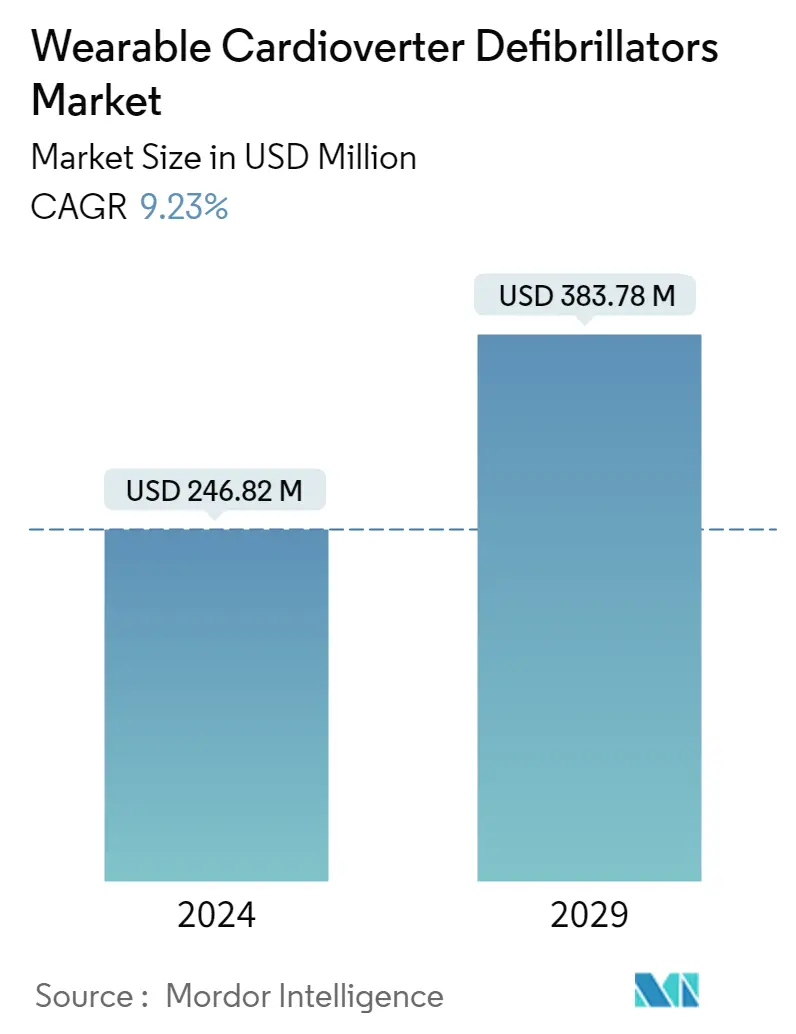Market Size of Wearable Cardioverter Defibrillators Industry

| Study Period | 2021 - 2029 |
| Market Size (2024) | USD 246.82 Million |
| Market Size (2029) | USD 383.78 Million |
| CAGR (2024 - 2029) | 9.23 % |
| Fastest Growing Market | Asia-Pacific |
| Largest Market | North America |
| Market Concentration | Medium |
Major Players
*Disclaimer: Major Players sorted in no particular order |
Wearable Cardioverter Defibrillators Market Analysis
The Wearable Cardioverter Defibrillators Market size is estimated at USD 246.82 million in 2024, and is expected to reach USD 383.78 million by 2029, growing at a CAGR of 9.23% during the forecast period (2024-2029).
The COVID-19 pandemic significantly impacted the growth of the wearable cardioverter defibrillator market. An article published in Nature Medicine in February 2022 observed that people with COVID-19 are more likely to have cardiovascular diseases, such as heart failure, thromboembolic disorders, dysrhythmias, ischemic and non-ischemic heart disease, pericarditis, myocarditis, and ischemic and non-ischemic heart disease. Thus, the high burden of CVD-related diseases raised the demand for wearable cardioverter defibrillator devices to monitor heart rhythm during the pandemic period as they allowed contactless communication and tracking of medical conditions by clinicians. Moreover, with released restrictions and resumed cardiac treatment and services, the studied market is expected to grow over the forecast period.
Factors such as the increasing prevalence of cardiovascular disorders, the rising geriatric population, and the ease of use of non-invasive devices are boosting the market growth. For instance, as per BHF's 2022 report, more than 7.6 million people in the United Kingdom were living with cardiovascular diseases in 2021. Hence, cardiovascular diseases and their high prevalence is expected to increase the demand for regular monitoring of heart rhythm, propelling the market growth. Also, according to the October 2022 update of the CDC, about 805,000 people in the United States have a heart attack every year. Hence, cardiovascular diseases and their high prevalence is expected to increase the demand for regular monitoring of heart rhythm, propelling the market growth.
In addition, the increasing prevalence of obesity, diabetes, hypertension, and high cholesterol among the population is contributing to market growth. According to the 2022 statistics published by UNICEF World Obesity Atlas, more than 27 million children will suffer from obesity by 2030 in India. Thus, the expected increase in the obese population may increase the risk of atrial fibrillation (AF), which reduces blood flow and leads to a heart attack. This is anticipated to propel the demand for cardioverter defibrillator devices, bolstering the market growth.
Also, according to the 2022 statistics published by IDF, about 537 million adults aged between 20 and 79 were living with diabetes globally. This number is projected to increase to 643 million and 783 million by 2030 and 2045, respectively. High blood sugar caused by diabetes can damage the nerves that control the heart and blood vessels, leading to a variety of cardiovascular diseases, such as coronary artery disease, that impact the electrical conduction system in the heart, resulting in atrial fibrillation and ventricular arrhythmias. This raises the need for a common heart condition and rhythm monitoring, further expected to augment market growth.
Furthermore, the rising product approvals and increasing development of technologically advanced products are also expected to increase the market growth. For instance, in August 2021, the United States Food and Drug Administration granted pre-market approval to Kestra Medical Technologies ASSURE wearable cardioverter defibrillator (WCD) system, a wearable device with incorporated sensors, a cardiac rhythm monitor and a miniaturized automated external defibrillator. It is intended for the monitoring and treatment of patients who are at risk of sudden cardiac death.
Therefore, owing to the factors such as the growing burden of cardiovascular diseases and obesity, coupled with the launch of products, are expected to contribute to the growth of the market over the forecast period. However, regulatory uncertainty and privacy and information security issues in wearable devices are expected to hinder market growth over the forecast period.
Wearable Cardioverter Defibrillators Industry Segmentation
A wearable cardioverter defibrillator refers to a rechargeable external device that can be worn under clothing. It protects or prevents the wearer from potentially life-threatening sudden cardiac death. It is intended for temporary use as a bridge to an implantable cardioverter-defibrillator (ICD), heart transplantation, or for patients with heart failure with reduced ejection fraction.
The Wearable Cardioverter Defibrillators Market is Segmented by Demography (Pediatric, Adults, and Geriatric), End-user (Home, Hospitals and Cardiology Clinics, and Other End-users), and Geography (North America, Europe, Asia-Pacific, and Rest of the World). The report offers the value (in USD million) for the above segments.
| By Demography | |
| Pediatric | |
| Adults | |
| Geriatric |
| By End-user | |
| Home | |
| Hospitals and Cardiology Clinics | |
| Others End-users |
| By Geography | ||||||||
| ||||||||
| ||||||||
| ||||||||
| Rest of the World |
Wearable Cardioverter Defibrillators Market Size Summary
The wearable cardioverter defibrillator market is poised for significant growth, driven by the increasing prevalence of cardiovascular disorders and the rising geriatric population. The demand for these non-invasive devices is bolstered by the need for regular heart rhythm monitoring, particularly in regions with high rates of cardiovascular diseases. The market's expansion is further supported by technological advancements and product approvals, such as the FDA's pre-market approval of Kestra Medical Technologies' ASSURE system. The COVID-19 pandemic has also played a role in accelerating market growth, as the virus has been linked to a higher incidence of cardiovascular conditions, thereby increasing the demand for wearable devices that facilitate contactless monitoring and communication with healthcare providers.
North America is expected to dominate the wearable cardioverter defibrillator market, attributed to its high healthcare expenditure, favorable reimbursement policies, and the growing adoption of non-invasive devices. The region's aging population, coupled with a rising burden of cardiovascular diseases, underscores the need for regular cardiac rhythm monitoring. The market is moderately consolidated, with major players like LivaNova PLC, Koninklijke Philips NV, and Medtronic PLC leading the charge. As awareness levels rise and the prevalence of cardiovascular diseases continues to grow, the market is anticipated to witness increased participation from regional players, further enhancing its competitive landscape.
Wearable Cardioverter Defibrillators Market Size - Table of Contents
-
1. MARKET DYNAMICS
-
1.1 Market Overview
-
1.2 Market Drivers
-
1.2.1 Increasing Prevelance of Cardiovascular Disorders
-
1.2.2 Increasing Elderly Population
-
1.2.3 Ease of Use for Non-invasive Devices
-
-
1.3 Market Restraints
-
1.3.1 Regulatory Uncertainty
-
1.3.2 Privacy and Information Security Issues in Wearable Devices
-
-
1.4 Industry Attractiveness - Porter's Five Forces Analysis
-
1.4.1 Threat of New Entrants
-
1.4.2 Bargaining Power of Buyers
-
1.4.3 Bargaining Power of Suppliers
-
1.4.4 Threat of Substitute Products
-
1.4.5 Intensity of Competitive Rivalry
-
-
-
2. MARKET SEGMENTATION (Market Size by Value - USD Million)
-
2.1 By Demography
-
2.1.1 Pediatric
-
2.1.2 Adults
-
2.1.3 Geriatric
-
-
2.2 By End-user
-
2.2.1 Home
-
2.2.2 Hospitals and Cardiology Clinics
-
2.2.3 Others End-users
-
-
2.3 By Geography
-
2.3.1 North America
-
2.3.1.1 United States
-
2.3.1.2 Canada
-
2.3.1.3 Mexico
-
-
2.3.2 Europe
-
2.3.2.1 Germany
-
2.3.2.2 United Kingdom
-
2.3.2.3 France
-
2.3.2.4 Italy
-
2.3.2.5 Spain
-
2.3.2.6 Rest of Europe
-
-
2.3.3 Asia-Pacific
-
2.3.3.1 China
-
2.3.3.2 Japan
-
2.3.3.3 India
-
2.3.3.4 Australia
-
2.3.3.5 South Korea
-
2.3.3.6 Rest of Asia-Pacific
-
-
2.3.4 Rest of the World
-
-
Wearable Cardioverter Defibrillators Market Size FAQs
How big is the Wearable Cardioverter Defibrillators Market?
The Wearable Cardioverter Defibrillators Market size is expected to reach USD 246.82 million in 2024 and grow at a CAGR of 9.23% to reach USD 383.78 million by 2029.
What is the current Wearable Cardioverter Defibrillators Market size?
In 2024, the Wearable Cardioverter Defibrillators Market size is expected to reach USD 246.82 million.

